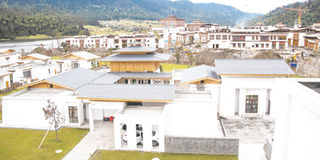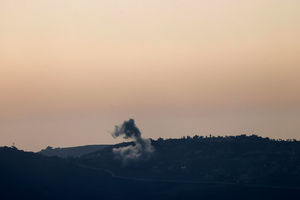China pushes Tibetan tourism amid criticism

A construction site behind chalets of the Artel hotel in Lulang, near Nyingchi in China’s Tibet Autonomous Region.
China has unveiled a sparkling new hotel as part of its drive to get tens of millions more tourists to visit Tibet, even as critics say the push is slowly eroding the local culture. PHOTO | AFP
What you need to know:
- With a presidential suite that costs $1,000 a night and views over the snow-capped mountains of the Himalayas, the luxury Artel hotel is a potent symbol of Chinese plans for the autonomous territory.
Nyingchi. China has unveiled a sparkling new hotel as part of its drive to get tens of millions more tourists to visit Tibet, even as critics say the push is slowly eroding the local culture.
With a presidential suite that costs $1,000 a night and views over the snow-capped mountains of the Himalayas, the luxury Artel hotel is a potent symbol of Chinese plans for the autonomous territory.
Tourism officials are hoping to see visitor numbers increase by nearly 50 percent in the next four years, said Wang Songping, deputy director of the Tibet Tourism Development Commission.
“Tibet attracted four million Chinese tourists in 2005. We hope we’ll get 24 million this year and 35 million by 2020,” he said.
Critics say the influx will lead to more of China’s dominant Han ethnic group settling in Tibet and eroding native Tibetan ways of life, and argue the majority of economic benefits of mass tourism will not go to locals.
Official figures say that Tibetans currently make up 90 percent of the local population, but groups opposed to Chinese rule say the real figure is significantly lower.
Beijing says it “peacefully liberated” Tibet in 1951 and insists it has brought development to a previously backward region where serfs were exploited.
But many Tibetans accuse Beijing of repressing their religion, diluting their culture and exploiting natural resources to benefit the Han at the expense of locals and the environment.
- Switzerland of the East -
The 103-room Artel opened in mid-August in Lulang, a picturesque village situated at 3,700 metres (12,100 feet) in a southeastern forested area in the autonomous region of Tibet.
It is part of a tourist complex built in an old part of town previously occupied mostly by government buildings and restaurants, that now boasts its own shopping street, a lake and an arts centre.
Nicknamed the “Switzerland of the East”, the village is seen by authorities as a flagship project for its ambitious plans for Tibet’s tourist sector.
Transport links are being developed to cater for the influx, including a motorway opening next year, and a high-speed rail line from the capital Lhasa, expected to open in 2021.
Another high-speed rail line to Chengdu, capital of neighbouring Sichuan province, home to more than 80 million people, should be completed in 2022.
Wang said the number of Chinese tourists, who currently make up 95 percent of visitors to Tibet, has increased by an average of 20 percent each year since the 2006 opening of the first railway linking Tibet to the rest of China.
But while outside visitors can boost the local economy, mass tourism has down sides, said Tibet expert Francoise Robin.
“Cultural performances shown to visitors are either favourable reinterpretations of Chinese history or Chinese versions of songs or dances,” she said. (AFP)




